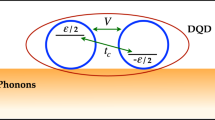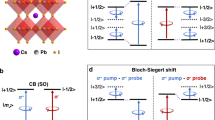Abstract
Synchronized dynamics of quantum dot (QD) ensembles are essential for generating ultrafast and giant optical responses beyond those of individual QDs. Increasing the strength of the direct electronic coupling between QDs is a key strategy for the realization of cooperative quantum phenomena. Here, we observe a quantum cooperative effect on nonlinear photocurrents caused by the coherent electronic coupling in semiconductor QD solids. We measure quantum interference signals cooperatively generated in QD solids. We control the inter-QD distance with atomic precision using bidentate ligands that strongly link the QDs. The harmonic quantum interference signals are strongly enhanced when shortening the molecular length of the ligand. Furthermore, we clarify that the coherence length of multiexcitons extends to neighbouring QDs. This finding is direct evidence that multiexciton coherent tunnelling assists the ultrafast exciton delocalization. Cooperative enhancement in QD solids may find application in advanced quantum optoelectronics.
This is a preview of subscription content, access via your institution
Access options
Access Nature and 54 other Nature Portfolio journals
Get Nature+, our best-value online-access subscription
$29.99 / 30 days
cancel any time
Subscribe to this journal
Receive 12 print issues and online access
$259.00 per year
only $21.58 per issue
Buy this article
- Purchase on Springer Link
- Instant access to full article PDF
Prices may be subject to local taxes which are calculated during checkout






Similar content being viewed by others
Data availability
The data that support the findings of this study are available from the corresponding authors upon reasonable request.
References
Dicke, R. H. Coherence in spontaneous radiation processes. Phys. Rev. 93, 99–110 (1954).
Skribanowitz, N., Herman, I. P., MacGillivray, J. C. & Feld, M. S. Observation of Dicke superradiance in optically pumped HF gas. Phys. Rev. Lett. 30, 309–312 (1973).
Gibbs, H. M., Vrehen, Q. H. F. & Hikspoors, H. M. J. Single-pulse superfluorescence in cesium. Phys. Rev. Lett. 39, 547–550 (1977).
Frolov, S. V. et al. Cooperative emission in π-conjugated polymer thin films. Phys. Rev. Lett. 78, 729–732 (1997).
Zhang, Q. et al. Superradiant decay of cyclotron resonance of two-dimensional electron gases. Phys. Rev. Lett. 113, 047601 (2014).
Zhang, Q. et al. Collective non-perturbative coupling of 2D electrons with high-quality-factor terahertz cavity photons. Nat. Phys. 12, 1005–1011 (2016).
Li, X. et al. Observation of Dicke cooperativity in magnetic interactions. Science 361, 794–797 (2018).
Scheibner, M. et al. Superradiance of quantum dots. Nat. Phys. 3, 106–110 (2007).
Rainò, G. et al. Superfluorescence from lead halide perovskite quantum dot superlattices. Nature 563, 671–675 (2018).
Cherniukh, I. et al. Perovskite-type superlattices from lead halide perovskite nanocubes. Nature 593, 535–542 (2021).
Murray, C. B., Kagan, C. R. & Bawendi, M. G. Self-organization of CdSe nanocrystallites into three-dimensional quantum dot superlattices. Science 270, 1335–1338 (1995).
Murray, C. B., Kagan, C. R. & Bawendi, M. G. Synthesis and characterization of monodisperse nanocrystals and close-packed nanocrystal assemblies. Annu. Rev. Mater. Sci. 30, 545–610 (2000).
Beard, M. C. et al. Variations in the quantum efficiency of multiple exciton generation for a series of chemically treated PbSe nanocrystal films. Nano Lett. 9, 836–845 (2009).
Tang, J. et al. Colloidal-quantum-dot photovoltaics using atomic-ligand passivation. Nat. Mater. 10, 765–771 (2011).
Ono, M. et al. Impact of surface ligands on the photocurrent enhancement due to multiple exciton generation in close-packed nanocrystal thin films. Chem. Sci. 5, 2696–2701 (2014).
Kagan, C. R. & Murray, C. B. Charge transport in strongly coupled quantum dot solids. Nat. Nanotechnol. 10, 1013–1026 (2015).
Proppe, A. H. et al. Picosecond charge transfer and long carrier diffusion lengths in colloidal quantum dot solids. Nano Lett. 18, 7052–7059 (2018).
Karki, K. J. et al. Coherent two-dimensional photocurrent spectroscopy in a PbS quantum dot photocell. Nat. Commun. 5, 5869 (2014).
Tahara, H., Sakamoto, M., Teranishi, T. & Kanemitsu, Y. Harmonic quantum coherence of multiple excitons in PbS/CdS core-shell nanocrystals. Phys. Rev. Lett. 119, 247401 (2017).
Tahara, H., Sakamoto, M., Teranishi, T. & Kanemitsu, Y. Quantum coherence of multiple excitons governs absorption cross-sections of PbS/CdS core/shell nanocrystals. Nat. Commun. 9, 3179 (2018).
Schaller, R. D. & Klimov, V. I. High efficiency carrier multiplication in PbSe nanocrystals: implications for solar energy conversion. Phys. Rev. Lett. 92, 186601 (2004).
Ellingson, R. J. et al. Highly efficient multiple exciton generation in colloidal PbSe and PbS quantum dots. Nano Lett. 5, 865–871 (2005).
Shabaev, A., Efros, Al. L. & Nozik, A. J. Multiexciton generation by a single photon in nanocrystals. Nano Lett. 6, 2856–2863 (2006).
Semonin, O. E. et al. Peak external photocurrent quantum efficiency exceeding 100% via MEG in a quantum dot solar cell. Science 334, 1530–1533 (2011).
Shabaev, A., Hellberg, C. S. & Efros, A. L. Efficiency of multiexciton generation in colloidal nanostructures. Acc. Chem. Res. 46, 1242–1251 (2013).
Tahara, H., Sakamoto, M., Teranishi, T. & Kanemitsu, Y. Collective enhancement of quantum coherence in coupled quantum dot films. Phys. Rev. B 104, L241405 (2021).
Hines, M. A. & Scholes, G. D. Colloidal PbS nanocrystals with size-tunable near-infrared emission: observation of post-synthesis self-narrowing of the particle size distribution. Adv. Mater. 15, 1844–1849 (2003).
Pattantyus-Abraham, A. G. et al. Depleted-heterojunction colloidal quantum dot solar cells. ACS Nano 4, 3374–3380 (2010).
Kang, I. & Wise, F. W. Electronic structure and optical properties of PbS and PbSe quantum dots. J. Opt. Soc. Am. B 14, 1632–1646 (1997).
Tahara, H. & Kanemitsu, Y. Quantum interference measurements and their application to analysis of ultrafast photocarrier dynamics in semiconductor solar cell materials. Adv. Quantum Technol. 3, 1900098 (2020).
Klimov, V. I., McGuire, J. A., Schaller, R. D. & Rupasov, V. I. Scaling of multiexciton lifetimes in semiconductor nanocrystals. Phys. Rev. B 77, 195324 (2008).
Zhang, Z. et al. Ultrafast exciton transport at early times in quantum dot solids. Nat. Mater. 21, 533–539 (2022).
Acknowledgements
Part of this work was supported by JSPS KAKENHI grant nos. JP19H05465 (Y.K. and H.T.), JP22H01990 (H.T.) and JP23K17877 (H.T.), JST-CREST grant no. JPMJCR21B4 (T.T. and Y.K.) and JST-FOREST grant no. JPMJFR201M (M.S.).
Author information
Authors and Affiliations
Contributions
H.T. conceived and designed the research. H.T. performed the experiments and analysed the data. M.S. and T.T. synthesized the QDs and fabricated the QD films. Y.K. supervised the project. All authors discussed the results and contributed to the writing of the paper.
Corresponding authors
Ethics declarations
Competing interests
The authors declare no competing interests.
Peer review
Peer review information
Nature Nanotechnology thanks the anonymous reviewers for their contribution to the peer review of this work.
Additional information
Publisher’s note Springer Nature remains neutral with regard to jurisdictional claims in published maps and institutional affiliations.
Extended data
Extended Data Fig. 1 Optical and electrical properties of QD films.
a, Absorption spectra of C2 (blue), C3 (green), C4 (red), and C5 (black) films. Their normalized spectra are shown in the main text (see Fig. 1c). b, Current-voltage characteristic of a representative C2 film under air mass 1.5 illumination.
Extended Data Fig. 2 Photocurrent quantum interference signals.
Photocurrent quantum interference signals of a C2 film are shown by black solid curves for different excitation photon fluences. The average numbers of absorbed photons per QD are (a) 0.5, (b) 1.1, and (c) 1.7. The photocurrent interference curves show stronger deformations with increasing excitation photon fluence. Excitation pulse interference signals (red dashed curves) were measured simultaneously.
Extended Data Fig. 3 Coupling strengths.
Coupling strengths of (a) \(2\omega\), (b) \(3\omega\), and (c) \(4\omega\) oscillations are plotted as a function of the square root of QD density. The coupling strengths are proportional to the square root of QD density. The QD density is evaluated from the average QD diameter and the lengths of ligand molecules in close packing. Error bars are the standard deviations of the fitting parameters. Dashed curves are guides for the eye.
Rights and permissions
Springer Nature or its licensor (e.g. a society or other partner) holds exclusive rights to this article under a publishing agreement with the author(s) or other rightsholder(s); author self-archiving of the accepted manuscript version of this article is solely governed by the terms of such publishing agreement and applicable law.
About this article
Cite this article
Tahara, H., Sakamoto, M., Teranishi, T. et al. Coherent electronic coupling in quantum dot solids induces cooperative enhancement of nonlinear optoelectronic responses. Nat. Nanotechnol. (2024). https://doi.org/10.1038/s41565-024-01601-9
Received:
Accepted:
Published:
DOI: https://doi.org/10.1038/s41565-024-01601-9



